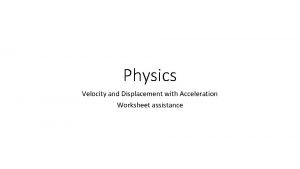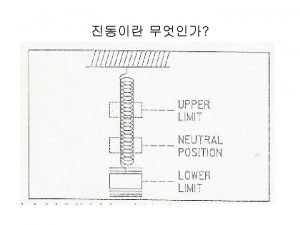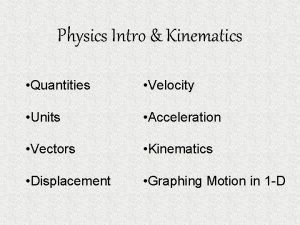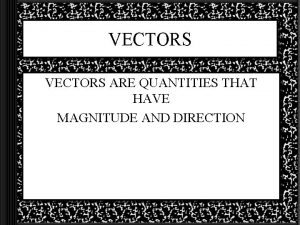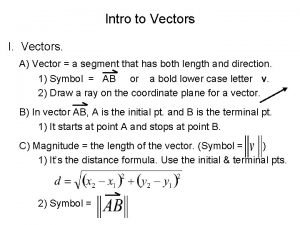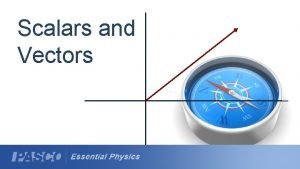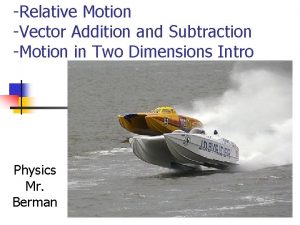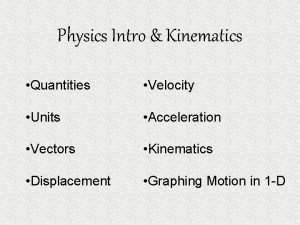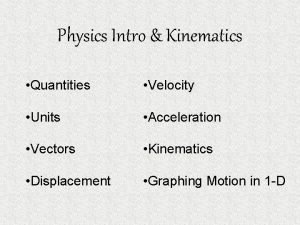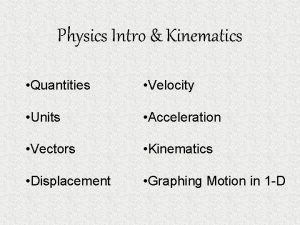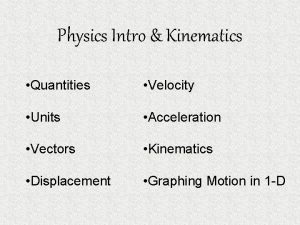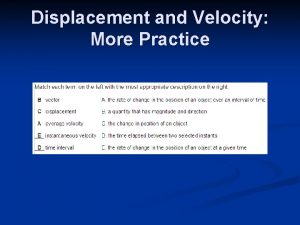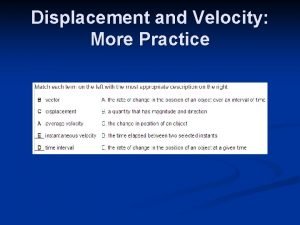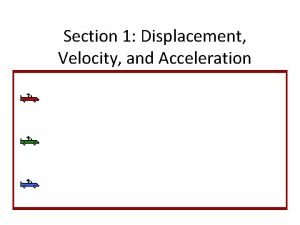Physics Intro Quantities Velocity Units Acceleration Vectors Displacement














- Slides: 14

Physics Intro • Quantities • Velocity • Units • Acceleration • Vectors • Displacement

Some Physics Quantities Vector - quantity with both magnitude (size) and direction Scalar - quantity with magnitude only Vectors: • Displacement Scalars: • Distance • Velocity • Acceleration • Momentum • Force • Speed • Time • Mass • Energy

Mass vs. Weight Mass • Scalar (no direction) • Measures the amount of matter in an object Weight • Vector (points toward center of Earth) • Force of gravity on an object On the moon, your mass would be the same, but the magnitude of your weight would be less.

Vectors are represented with arrows • The length of the arrow represents the magnitude (how far, how fast, how strong, etc, depending on the type of vector). 5 m/s 42° • The arrow points in the directions of the force, motion, displacement, etc. It is often specified by an angle.

Units are not the same as quantities! Quantity. . . Unit (symbol) • Displacement & Distance. . . meter (m) • Time. . . second (s) • Velocity & Speed. . . (m/s) • Acceleration. . . (m/s 2) • Mass. . . kilogram (kg) • Momentum. . . (kg · m/s) • Force. . . Newton (N) • Energy. . . Joule (J)

SI Prefixes Little Guys Big Guys

Kinematics definitions • Kinematics – branch of physics; study of motion • Position (x) – where you are located • Distance (d ) – how far you have traveled, regardless of direction • Displacement ( x) – where you are in relation to where you started

Distance vs. Displacement • You drive the path, and your odometer goes up by 8 miles (your distance). • Your displacement is the shorter directed distance from start to stop (green arrow). • What if you drove in a circle? start stop

Speed, Velocity, & Acceleration • Speed (v) – how fast you go • Velocity (v) – how fast and which way; the rate at which position changes • Average speed ( v ) – distance / time • Acceleration (a) – how fast you speed up, slow down, or change direction; the rate at which velocity changes

Speed vs. Velocity • Speed is a scalar (how fast something is moving regardless of its direction). Ex: v = 20 mph • Speed is the magnitude of velocity. • Velocity is a combination of speed and direction. Ex: v = 20 mph at 15 south of west • The symbol for speed is v. • The symbol for velocity is type written in bold: v or hand written with an arrow: v

Speed vs. Velocity • During your 8 mi. trip, which took 15 min. , your speedometer displays your instantaneous speed, which varies throughout the trip. • Your average speed is 32 mi/hr. • Your average velocity is 32 mi/hr in a SE direction. • At any point in time, your velocity vector points tangent to your path. • The faster you go, the longer your velocity vector.

Acceleration – how fast you speed up, slow down, or change direction; it’s the rate at which velocity changes. Two examples: t (s) v (mph) t (s) v (m/s) 0 55 0 34 1 57 1 31 2 59 2 28 3 61 3 25 a = +2 mph / s m/s a = -3 s = -3 m / s 2

Velocity & Acceleration Sign Chart VELOCITY A C C E L E R A T I O N + - Moving forward; Moving backward; Speeding up Slowing down Moving forward; Moving backward; Slowing down Speeding up

Acceleration due to Gravity Near the surface of the Earth, all objects accelerate at the same rate (ignoring air resistance). This acceleration vector is the same on the way up, at the top, and on the way down! a = -g = -9. 8 m/s 2 Interpretation: Velocity decreases by 9. 8 m/s each second, meaning velocity is becoming less positive or more negative. Less positive means slowing down while going up. More negative means speeding up while going down.
 Units, physical quantities and vectors
Units, physical quantities and vectors Base and derived quantities
Base and derived quantities Displacement and velocity worksheet
Displacement and velocity worksheet Vibration displacement velocity acceleration
Vibration displacement velocity acceleration Final velocity initial velocity acceleration time
Final velocity initial velocity acceleration time Constant acceleration speed time graph
Constant acceleration speed time graph Units for velocity
Units for velocity Relationship between linear and angular quantities
Relationship between linear and angular quantities Vectors are quantities that have magnitude only
Vectors are quantities that have magnitude only Magnitude of unit vector formula
Magnitude of unit vector formula Intro to vectors
Intro to vectors Adding displacement vectors
Adding displacement vectors Single displacement vs double displacement
Single displacement vs double displacement Adding velocity vectors
Adding velocity vectors Grammar expressions of quantity
Grammar expressions of quantity


